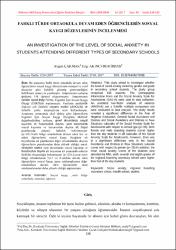| dc.contributor.author | Çakmak, Aygen | |
| dc.contributor.author | Demirbaş, Ezgi Akıncı | |
| dc.date.accessioned | 2020-06-25T14:32:35Z | |
| dc.date.available | 2020-06-25T14:32:35Z | |
| dc.date.issued | 2017 | |
| dc.identifier.citation | Çakmak, A., Demirbaş, E. A. (2017). Farklı Türde Ortaokula Devam Eden Öğrencilerin Sosyal Kaygı Düzeylerinin İncelenmesi. Mehmet Akif Ersoy Üniversitesi Eğitim Fakültesi Dergisi, 0(43), 138 - 155. | en_US |
| dc.identifier.issn | 1302-8944 | |
| dc.identifier.issn | 2146-5983 | |
| dc.identifier.uri | https://app.trdizin.gov.tr/publication/paper/detail/TWpNNU9UVTNOdz09 | |
| dc.identifier.uri | https://hdl.handle.net/20.500.12587/60 | |
| dc.description.abstract | Bu araştırma farklı türde ortaokula devam eden öğrencilerin sosyal kaygı düzeylerinin cinsiyet ve sınıf düzeyine göre farklılık gösterip göstermediğini belirlemek amacıyla yapılmıştır. Araştırmanın çalışma grubunu 158 öğrenci oluşturmuştur. Araştırmanın verileri Genel Bilgi Formu, Ergenler İçin Sosyal Kaygı Ölçeği (ESKÖ)ile toplanmıştır. Verilerin analizinde ilişkisiz çift faktörlü varyans analizi (ANOVA) ve Scheffe çoklu karşılaştırma testi kullanılmıştır. Araştırma sonucunda okul türüne göre öğrencilerin Ergenler İçin Sosyal Kaygı Ölçeğinin olumsuz değerlendirilme korkusu, genel durumlarda sosyal kaçınma ve huzursuzluk duyma, yeni durumlarda sosyal kaçınma ve huzursuzluk duyma alt boyut puanlarında (p.05).Yatılı bölge ortaokuluna devam eden kız ve erkek öğrencilerin sosyal kaygı ölçeğinin alt boyutlarına ait puanlarının diğer ortaokullarda okuyan öğrencilerin puanlarından daha yüksek olduğu ancak cinsiyetin sadece yeni durumlarda sosyal kaçınma ve huzursuzluk duyma alt boyutuna ait puanlarda anlamlı farklılık oluşturduğu bulunmuştur (p.05).Ayrıca yatılı bölge ortaokulunun 5,6,7 ve 8.sınıfına devam eden öğrencilerin sosyal kaygı puan ortalamalarının diğer ortaokullara ortalamalarından daha yüksek olduğu saptanmıştır. | en_US |
| dc.description.abstract | This study aimed to investigate whether the level of social anxiety varied by gender and grade in secondary school students. The study group comprised Information Form and the Social Anxiety Scale for Adolescents (SAS-A) were used in data collection. An unrelated two-factor analysis of variance (ANOVA) and a Scheffe multiple comparison test were conducted in data analysis. The study results revealed a significant difference in the Fear of Negative Evaluation, General Social Avoidance and Distress and Social Avoidance and Distress in New Situations subscales of the Social Anxiety Scale for Adolescents with respect to school type (p.05). Both female and male boarding students scored higher than the day students in all subscales of the Social Anxiety Scale for Adolescents. However, there was in a significant difference only in the Social Avoidance and Distress in New Situations subscale scores with respect to gender (p.05).In addition, the mean social anxiety scores of the students who attended the fifth, sixth, seventh and eighth grades of the regional boarding secondary school were higher than that of the day students | en_US |
| dc.language.iso | tur | en_US |
| dc.rights | info:eu-repo/semantics/openAccess | en_US |
| dc.subject | Eğitim, Eğitim Araştırmaları | en_US |
| dc.title | Farklı Türde Ortaokula Devam Eden Öğrencilerin Sosyal Kaygı Düzeylerinin İncelenmesi | en_US |
| dc.title.alternative | An Investigation Of The Level Of Social Anxiety In Students Attending Different Types Of Secondary Schools | en_US |
| dc.type | article | en_US |
| dc.contributor.department | Kırıkkale Üniversitesi | en_US |
| dc.identifier.volume | 0 | en_US |
| dc.identifier.issue | 43 | en_US |
| dc.identifier.startpage | 138 | en_US |
| dc.identifier.endpage | 155 | en_US |
| dc.relation.journal | Mehmet Akif Ersoy Üniversitesi Eğitim Fakültesi Dergisi | en_US |
| dc.relation.publicationcategory | Makale - Ulusal Hakemli Dergi - Kurum Öğretim Elemanı | en_US |
















